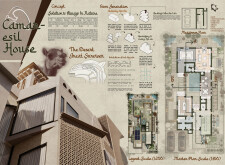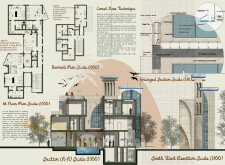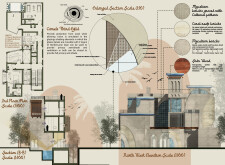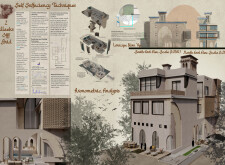5 key facts about this project
### Overview
The Camar-esil House is situated in a desert environment, designed to integrate modern living with ecological sustainability and cultural heritage. The project draws inspiration from the natural resilience seen in local wildlife, particularly the camel, to inform its architectural strategies and material choices. Through the application of innovative design methods, it addresses the unique challenges posed by its arid location, resulting in a functional residence that reflects a commitment to environmental and cultural contexts.
### Material Selection and Sustainable Practices
The material palette of the Camar-esil House emphasizes sustainability and local sourcing. Mycelium bricks, characterized by their lightweight and water-resistant properties, significantly reduce carbon emissions during production. Local Sidr wood offers a high strength-to-weight ratio, minimizing transportation impacts. Additionally, sustainably extracted coral reef bricks enhance the aesthetic while ensuring environmental responsibility. Concrete and reinforced slabs provide necessary structural support, while burlap, paired with glass panels, fosters moisture management and natural light penetration.
Sustainable energy solutions are integral to the design, featuring photovoltaic solar panels that enable off-grid functionality. Natural ventilation strategies, including chimney systems and strategically placed openings, optimize air circulation for thermal comfort without relying on mechanical cooling.
### Spatial Configuration and Cultural Integration
The spatial organization of the Camar-esil House comprises multiple interconnected levels, designed to facilitate privacy and space utilization for multiple families, thereby encouraging communal living. The incorporation of indoor plant systems leverages evaporation techniques to enhance air quality and indoor climate control.
Culturally, the design incorporates architectural motifs linked to local traditions, such as patterned mycelium bricks and ornamental features that resonate with the surrounding environment. Furthermore, innovative cooling strategies, including the "Camel Nose Technique," utilize glass prisms to capture and redistribute moisture from ambient air, highlighting a nuanced understanding of the desert climate. The dual-layered blinds enhance privacy while allowing for adaptive light control, maintaining both comfort and connection to the landscape.





















































